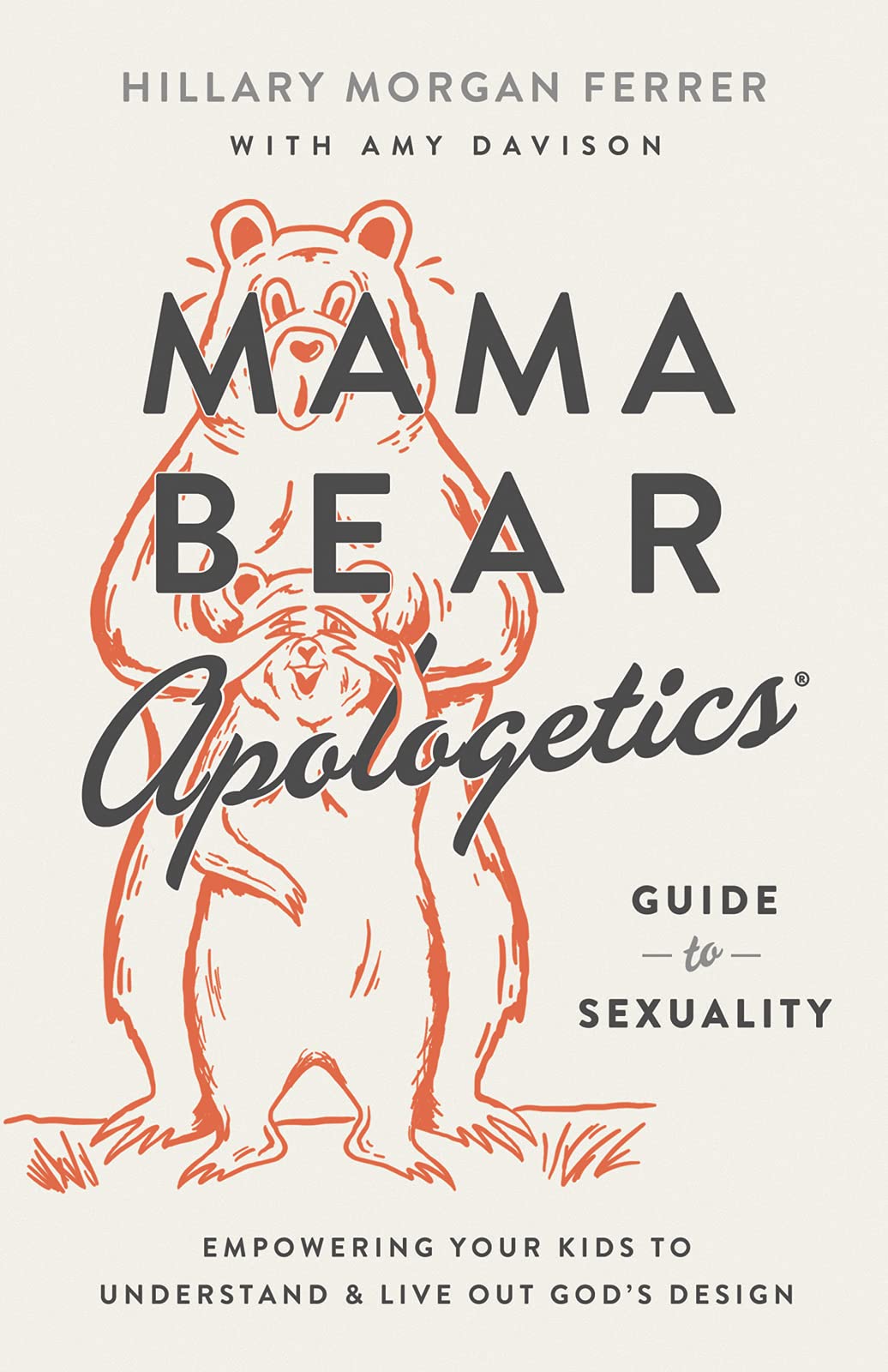“My third-grader has a classmate who was a boy last year, but his parents have let everyone know he’s a girl this year. How should I talk to my son about it?”
“We found out our kindergartner will be learning about The Genderbread Person. Should we keep her home from school on those days?”
“Our middle-school daughter’s basketball team has a boy on it. Any advice on how to handle that from the sidelines?”
These real-life questions were recently posed to me, and more like them regularly make their way into my inbox and into personal conversations. Parents are worried and overwhelmed, as our children are growing up in an era unlike our own and the rules keep changing fast. We aren’t sure how to process the latest social norms, let alone help our children do the same.

Mama Bear Apologetics Guide to Sexuality: Empowering Your Kids to Understand and Live Out God’s Design
Hillary Morgan Ferrer
Mama Bear Apologetics Guide to Sexuality: Empowering Your Kids to Understand and Live Out God’s Design
Hillary Morgan Ferrer
Starting at a young age, kids are being fed damaging misinformation about sexuality, gender identity, and human biology. As a parent, it’s up to you to help your children understand God’s truth about these integral concepts in the face of the candy-coated lies that saturate today’s world.
In the footsteps of the bestselling Mama Bear Apologetics comes this invaluable guide to training your kids to know and respect God’s design in a world that has rejected it. This book will equip you to:
- understand God’s design for gender, sex, marriage, and family as a beautiful portrait that reveals the nature of God himself
- identify the tactics being used to trick children into adopting an unbiblical view of sexuality under the guise of Christian-sounding words like love, identity, tolerance, and justice
- teach your kids to treat those who hold different beliefs with gentle, Christlike compassion without compromising biblical values
As society continues to blur the lines of what is good, true, and acceptable, God’s standards remain clear and unchanging. This book will give you the wisdom to confidently raise your children to understand sex and gender through a biblical lens.
Mama Bear Apologetics Guide to Sexuality: Empowering Your Kids to Understand and Live Out God’s Design, written by Hillary Morgan Ferrer with Amy Davison, is a handbook for this cultural moment. It’s not only an explainer for 2021 but also a lighthouse of timeless and biblical truths to help us navigate our current age. Morgan Ferrar is the founder of Mama Bear Apologetics and Davison writes and podcasts for the organization, which teaches moms how to “raise kids who think critically, love biblically, and stand firm against the cultural tide.”
Felt Need
The felt need, or the itch that this book scratches, is that parents feel frantic. They want someone to sit down with them and catch them up on what’s happening and what to do about it. This book does that in three parts: (1) Things I Probably Already Knew . . . But Kinda Forgot, (2) Wait, My Kids Are Being Taught What?!, and (3) Things That Are Tripping Everyone Up. The 13 chapters conclude with discussion questions and ideas for discipling your kids with what you’ve just learned.
Parents find immediate assistance in the chapters that explain current curricula across the United States, define new vocabulary, and describe what is now considered normal or even celebrated in secular culture. Also included are action steps for parents to approach teachers and school boards if they’re concerned about what’s happening in their children’s schools.
While the authors’ tone itself is not alarmist, the contents of the book are indeed alarming, if you haven’t been paying very close attention. Moms and dads are likely to break a sweat as they read.
Moms and dads are likely to break a sweat as they read.
Deeper Need
While the Mama Bear Apologetics Guide to Sexuality does an excellent job of describing what’s going on, what I really love is how it exalts eternal truths which bring perspective to our temporary woes. The authors regularly point to the goodness and character of our Creator and Savior. In this way, the message not only serves to motivate parents to be deeply involved in their kids’ sexual discipleship, but it also roots them in the surpassing love and sufficient sovereignty of God in heaven.
With the loud and pervasive sexual agenda pressing in all around us, it can be tempting to place sexuality on the margin of our faith—a sort of optional conversation where our convictions can be mushy. But the authors compel us to see that what we believe about sexuality reveals what we believe about God. As they write, “much of the distortion surrounding gender, sex, and marriage can be traced back to a fundamental principle: the principle of authority” (49).
As we read we must ask ourselves if we have truly surrendered to the Author of our lives who has all authority and if we are modeling that for our children so they may do the same.
Because here’s what’s at stake: our kids’ security in Jesus. In this age of shifting sexual identities and the overwhelming encouragement to endlessly try them on, our kids are at a great risk for becoming disillusioned, discouraged, and depressed. Morgan Ferrar and Davison identify this cultural pitfall well:
If our kids think their identity is based on how they identify in the moment, then there is no security in Christ. If they don’t feel saved, then they aren’t. If they don’t feel like God is close to them at the moment, then he’s not. If they feel ugly, then they are. Don’t try to talk them out of it: The Genderbread Person taught them all about how to determine their identity. (117)
Of course, Christian parents understand identity much better than the Genderbread Person. And we can point our kids to a source of security beyond the messages in their classroom. While there’s a time and a place to advocate for our concerns over pronouns and bathrooms and boys on the girls’ team, the top priority for Christian parents in this moment is to do all we can to ensure our children are rooted firmly in the God who made them, died to save them, and sustains them. That is the only place they—and we—will find abundant life (John 10:10).
Truth in Humility
There is a recurring and refreshing theme in Mama Bear Apologetics Guide to Sexuality that is not always present in apologetics books or Christian works that address sexual sin. “We are called to love all—no matter their understanding of sexuality and gender,” the authors write. “We are called to love people and demolish bad ideas. May we never mistake the two. Never.” (129). The authors diligently remind the reader to uphold the truth, but always with grace, and to teach their children to do the same. They conclude, “We don’t have to compromise conviction to show compassion” (76).
This humble posture resurfaces many times, and it’s a relief to see. There are a handful of confessions on behalf of the church for ways we’ve fallen short in the past. The authors admonish the Christian community for scapegoating homosexuality, treating this one sexual sin as worse than any other, and rejecting homosexuals in our midst. They boldly state a corrective: “Same-sex attraction is not the unpardonable sin. The gospel is not about making gay people straight. The gospel is about transforming sinners into disciples of God” (173).
Morgan Ferrar and Davison offer a similar corrective of the church’s past purity movement: “overly zealous church leaders made virginity their primary focus, neglecting the redemptive work of Christ” (216–17). Acknowledging how we’ve got it wrong in the past conveys not only a commitment to getting it right now, but also our never-ending need for God’s grace and wisdom.
One Critique
In our polarized and soundbite-laden age, both secular and Christian thinkers alike have lumped together discussions on race and sexuality. Mama Bear Apologetics Guide to Sexuality makes this mistake, if only on a couple of pages in chapter five. The authors claim that Marxism is the taproot of ideas such as feminism, social justice, queer theory, intersectionality, and critical race theory. While it may be possible to trace a Marxist thread through these areas of study—depending on how one defines the terms—their complexity outweighs this brief mention.
This kind of teaching is dismissive of past and present racism when it waves the hand and says what kids are learning about social justice and critical race theory is the same as what they’re learning about sex and gender (92). While secular thinkers want to lump these two issues together (claiming the gay rights movement is the new civil rights movement), the church should work hard to keep them separate.
We are right to uphold a biblical sexual ethic and push against the current sexual tide in our age. We are also right to promote justice, equality, and integration when it comes to race. In the church we must acknowledge that Christians have a shameful history of defending slavery and segregation, as well as the mistreatment of LGBTQ people (as the authors acknowledge), so we must do all we can to separate the two issues now.
It’s simplistic and counterproductive to claim that someone promoting social justice does so from the same foundation as someone promoting gay and trans rights. The church in America still has much work to do on racial justice; I hate to see the issue minimized and lost in conversation on gender and sexuality. It deserves its own conversation. Rebecca McLaughlin’s book The Secular Creed has a helpful discussion on the combination of race and sexuality conversations in chapter 3.
Sexual Holiness
The closing chapter of Mama Bear Apologetics Guide to Sexuality is a grace- and truth-filled benediction to a helpful and timely book. Morgan Ferrar and Davison remind us, regarding sin, that “we were all born that way” (240). None of us is without sin, and none of us lives without temptation. They remind us that “sexual holiness is itself a cross we will have to carry—each one of us” (234).
None of us is without sin, and none of us lives without temptation.
The authors close by pointing again to what is eternally glorious and true: God “is infinitely worthy of us taking up our crosses—no matter what they may be. . . . May the Lord grant us love and compassion and understanding as we all carry our crosses, together” (240).
And this book is a tool to that end. I will eagerly recommend it to those who’ve asked about their son’s classmate, their kindergartner’s curriculum, their daughter’s basketball team, and to everyone else who reaches out for help and guidance in the ever-changing days ahead.

































